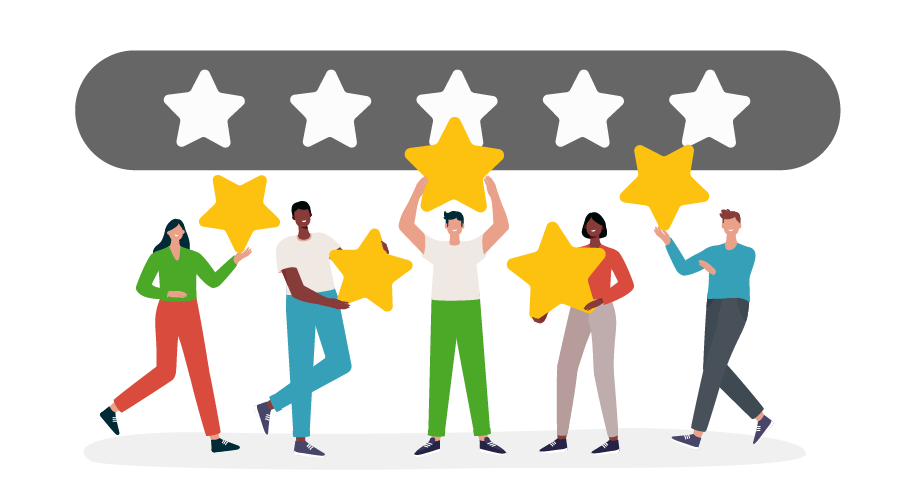Attracting new clients is only one aspect of a successful growth plan for brands across all industries. Even more crucial is retaining existing clients and developing strong brand loyalty. The market for loyalty programs is rapidly expanding. According to forecasts, the global loyalty management industry, which is presently valued at $8.6billion, will be worth more than $18.2 billion by 2026.
The market for engaging and sophisticated loyalty programs is growing more interesting as technological improvements and the increased adoption of omnichannel programs drive growth. Customer loyalty and retention marketers must have access to informative analytics and understand the standards for success to capitalize on this growth and excitement. Some of the most crucial loyalty statistics will be reviewed in this post.
Table of Contents
Top Customer Loyalty Statistics

Before getting into the details of the statistics, here are a few of the most important ones to start with:
- In 72\% of countries, customers feel loyal to at least one brand or firm.
- Customers are loyal to their favorite brands because of their price.
- According to 88\% of consumers, building brand loyalty takes three or more purchases.
- The market for loyalty management is valued at $4.43 billion.
- The average American customer is a member of 16.7 different customer loyalty programs.
- 57\% of Gen Z Americans are less brand loyal now than they were before the COVID-19 pandemic.
What Factors Influence Client Loyalty to a Brand?
It is entirely dependent on the customer. Older shoppers are more concerned with price and quality, whereas younger shoppers are more concerned with environmental and social impact. Customers might also be encouraged to stay by offering incentives such as customer loyalty and rewards programs.
According to the most recent customer loyalty statistics, while firms spend more money on loyalty management, consumers set a high standard for brands to whom they are devoted.
Brand Loyalty Statistics
Brand loyalty is a strong force. Customers stick with their favorite companies for years, if not their entire lives. But that doesn’t mean businesses can relax. Even the most committed consumers might be disconnected by poor customer service or misleading marketing.
In 72\% of countries, customers feel loyal to at least one brand or firm.
Over two-thirds of customers around the world say they are loyal to a brand. However, allegiance differs significantly amongst countries. Over 80\% of customers in the United States are loyal to a brand. Brand loyalty in Japan has dropped to just over 50\%.
59\% of American customers claim they are committed to a brand for the rest of their lives.
Americans have the rest of the world beat when it comes to consumer loyalty longevity. The United States boasts the world’s highest rate of lifetime customer loyalty.
75\% of Americans feel brands that understand them on a personal level are more likely to keep their loyalty.
Consumers expect a personalized experience, yet many are dissatisfied with how brands use their personal data.
According to 88\% of consumers, building brand loyalty takes three or more purchases.
Only 12\% think they’re ready to commit after two purchases, while 37\% say they need to make five or more purchases before committing to a brand.
Customers are loyal to their favorite brands because of their price.
According to a recent survey, price is the most significant consideration for 62\% of global customers, followed by customer service (57\%) and product or service offerings (54\%). Personalization and promotions are only essential to 27\% of worldwide customers when it comes to brand loyalty.
Customer service is “extremely important” in brand choice and loyalty, according to 56\% of global customers.
Customer service expectations are rising. Customer service is now more crucial to 59\% of consumers than a year ago.
61\% of global consumers have severed relations with a company due to bad customer service.
Maintaining customer loyalty requires excellent customer service. Customer service concerns have caused nearly half of customers (48\%) to abandon a brand in the last year.
Customers transfer brands because of lies regarding product performance.
If their favorite firm lied about product performance or efficiency, 31\% of American consumers would switch brands.
During the COVID-19 pandemic, 36\% of American consumers switched brands.
During the COVID-19 pandemic, three out of four Americans modified their shopping habits. 73\% of consumers in the United States who switched brands expect to stick with it.
Loyalty Management Statistics
Customers’ loyalty isn’t something brands hope for. They are constantly looking for new ways to entice loyal customers. Here’s a look at the loyalty management sector and how companies operate behind the scenes to develop brand loyalty.
The market for loyalty management is valued at $4.43 billion.
Brands spend a lot of money on loyalty management and will continue to do so in the future. By 2028, the loyalty management business might be valued at $18 billion. That’s an annual growth rate of 22.4 percent.
Customer loyalty management accounts for 23\% of global brand spending on the customer ecosystem.
Every year, brands spend $323 billion on their customer ecosystem, which includes loyalty management, customer engagement, CRM, and tech and transaction enablers. Brands spend more than $75 billion on loyalty management alone each year.
Over the last two years, 69\% of brand executives believe they’ve raised their loyalty investment.
Investing in loyalty appears to be paying off. Over half of those executives (55\%) believe they’ll boost loyalty spending even more in the coming two years.
The primary goal for firms engaging in customer loyalty programs is to attract new consumers.
Brands that invest in customer loyalty hope to achieve a number of good results. The most prevalent goal is to attract new clients, which is mentioned by 65\% of brand executives. Building emotional brand connections (57\%), learning about customer preferences (50\%), and generating brand advocacy are also goals (49\%).
Only 42\% of brand executives believe their customer loyalty programs are successful.
It’s possible that out-of-date loyalty methods are to blame, with 46\% of firms claiming that their customer loyalty initiatives aren’t innovative enough.
One of the top goals of content marketing for 50\% of marketers is to increase brand loyalty.
Although content marketing is typically used to attract new customers, marketers are increasingly using it to establish loyalty. Consumer brands are more likely than B2B enterprises to use content in their customer loyalty efforts.
Retention is increasingly more vital to eCommerce businesses than conversion or acquisition.
In the last two years, the expanding eCommerce business has moved its focus from acquiring new customers to retaining existing clients. The majority are using personalization to do this, with 74\% of eCommerce companies reporting increased attempts to personalize their websites.
Loyalty Program Statistics
Running a loyalty or rewards program is one of the most effective customer loyalty techniques. To increase consumer loyalty, brands offer both free and paid membership programs. With these subscriptions, shoppers can earn points, get free shipping, and other benefits.
The most prevalent reason customers detest loyalty programs is that they take too long to receive incentives.
45\% of customers are dissatisfied with the time it takes to receive rewards from loyalty programs. 31\% believe earning awards is too tough, while 27\% believe the prizes are not worth enough.
The average American customer is a member of 16.7 different customer loyalty programs.
Credit cards, high-frequency retail, mid-frequency retail, travel, and dining are the most popular loyalty and rewards programs.
64\% of loyalty program participants spend more money to optimize point gains.
Customers are more likely to spend on brands if they are given points. In high-income groups, this motivation grows. Consumers with incomes of $200,000 or more modify their shopping habits to maximize points.
After enrolling in a paid loyalty program, 62\% of consumers spend more money on that brand.
Customers are rewarded for remaining loyal to brands through paid loyalty programs. Paid loyalty members are more likely to prefer that brand over competitors, with 43\% making weekly purchases.
Consumers are twice as likely to spend money on a brand that offers a paid loyalty program than one that does not.
When customers have a paid loyalty membership, they spend 60\% more on the brand. With free memberships, the percentage reduces to just 30\%.
The biggest reason for not joining a loyalty program, according to 70\% of consumers, is the cost of membership.
While paid loyalty programs can encourage customers to spend more money, they can also turn potential customers away. Expensive fees are the top reason consumers say they would abandon a loyalty program.
With paid loyalty memberships, 58\% of American buyers expect free shipping and no order minimums.
39\% of buyers anticipate same-day delivery, while 31\% anticipate having more buying alternatives online than in stores.
Customer Loyalty Demographic Statistics
Brand loyalty exists for a variety of reasons. However, broader demographics and patterns can help to explain it.
Women in the United States are 15\% more likely than men to join a loyalty or rewards program.
Only 59\% of American males participate in a loyalty program, but 68\% of American women do.
In the United States, people aged 55 to 64 are the most likely to join a loyalty or rewards program.
Only 43\% of Americans aged 18-24 are members of a loyalty program, whereas 71\% of Americans aged 55-64 are members of at least one reward program.
Millennials are more likely to post positive evaluations for their favorite brands than Gen Xers and Baby Boomers.
Millennials are more likely than Gen Xers and Baby Boomers to give positive evaluations for their favorite brands, with 71\% saying they would.
Millennials skip client loyalty programs due to disappointing rewards.
Over half of millennials (57.7\%) say they would exit a brand’s loyalty program if the benefits were not appealing or relevant. Other causes for abandoning include waiting too long to gain points (48\%), having insufficient options to earn points (47.8\%), and programs being too complicated (45\%).
Millennials are 14 times more likely to use their smartphones to access loyalty programs than they are to use a PC.
According to millennials, mobile is the preferred medium for rewards programs. Mobile apps are preferred by 46\%, text message links by 28\%, and mobile wallets by 11\%.
Gen Z is more likely to pay more for apparel that is environmentally friendly or socially conscious.
74\% of Gen Z customers say they’d pay more for environmentally or socially conscious apparel. Only 59\% of Gen Xers felt this way, compared to 71\% of millennials.
57\% of Generation Z Americans are less brand loyal now than before the COVID-19 pandemic.
80\% of customers say they’re more inclined to try new brands now than before the pandemic, and 38 percent say they only give a brand a second opportunity before switching to a competitor.
Conclusion
It’s an exciting moment to be involved in loyalty marketing and retention strategies. Customer expectations are shifting, and most shoppers are prioritizing the customer experience. Companies should observe statistics like these and utilize them to know how customer expectations are changing and how best to respond.
Customer loyalty is a difficult topic with many moving aspects, as these figures demonstrate. To establish a loyal client base, brands have always had to focus on providing outstanding value and customer service. They must now assess their positions on a wide range of social and environmental issues. Furthermore, innovation may play a critical role in client loyalty. Brands may build personalized experiences for their customers through personalization and mobile solutions. Customers who feel understood by a brand are more inclined to shop with that brand again in the future. While brands develop, they must continue to listen to their customers or risk losing them to the competitors.
For more such content on market statistics, check out our statistics blogs.





